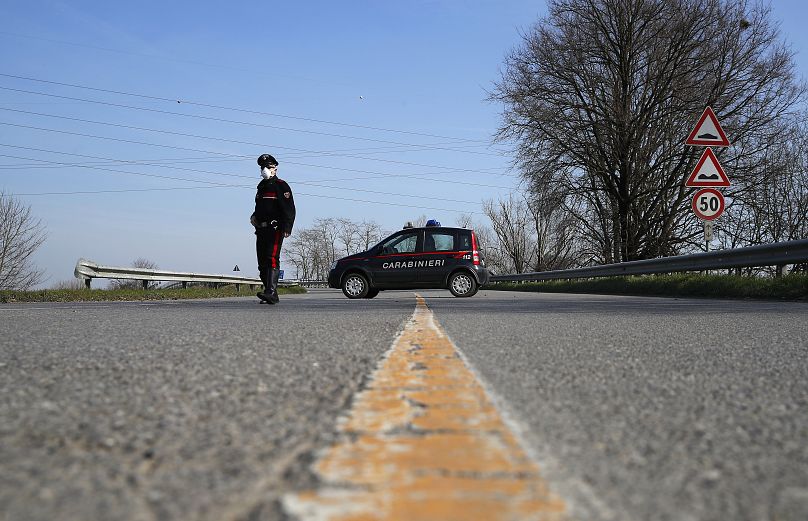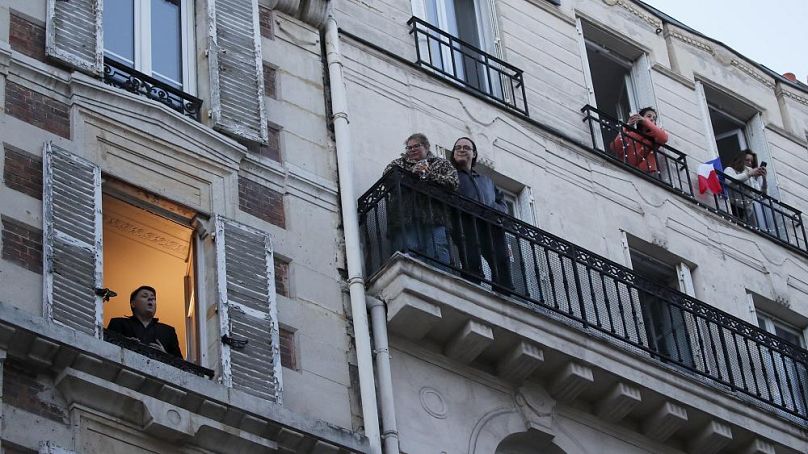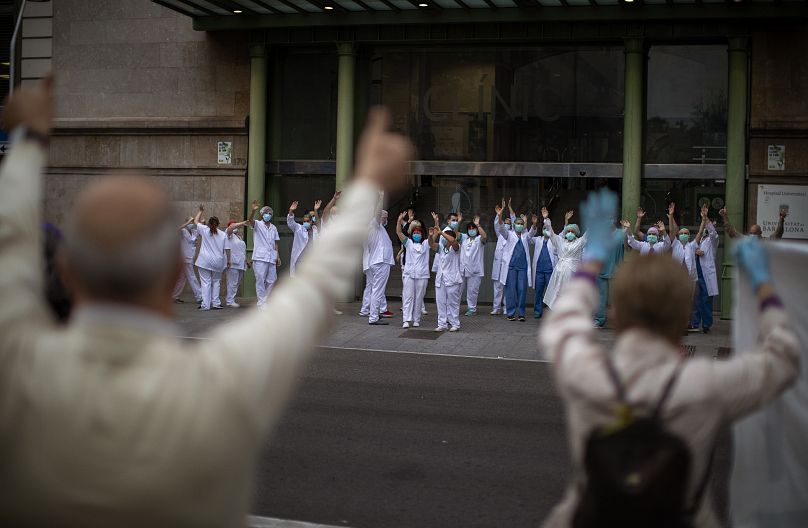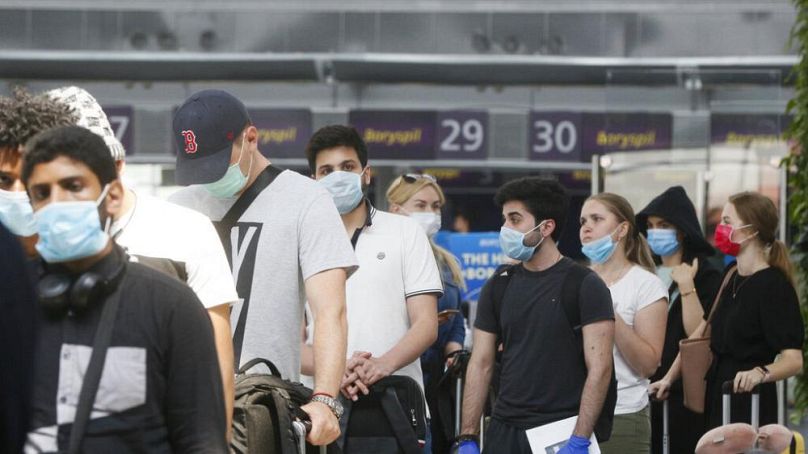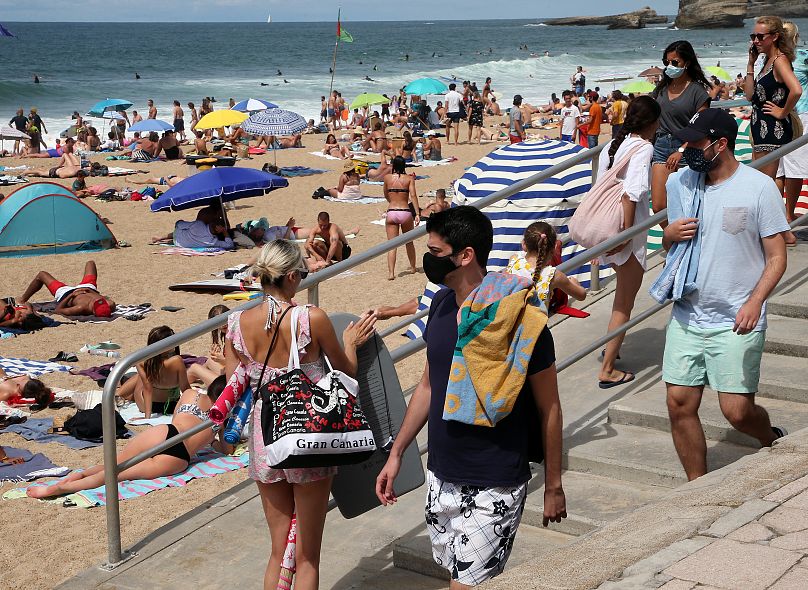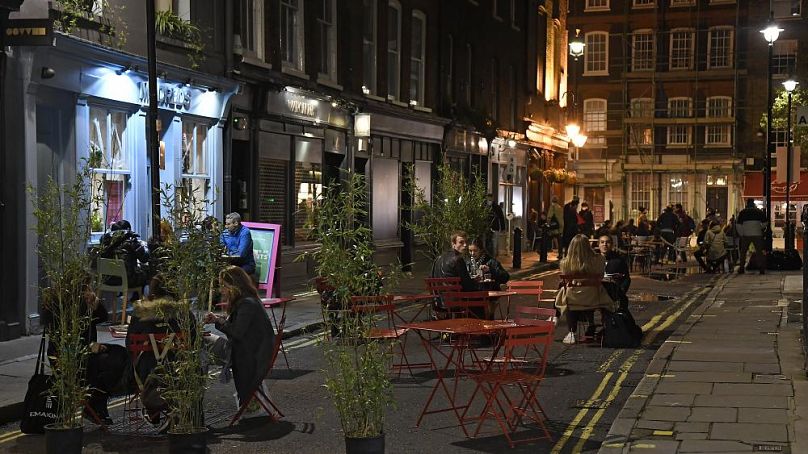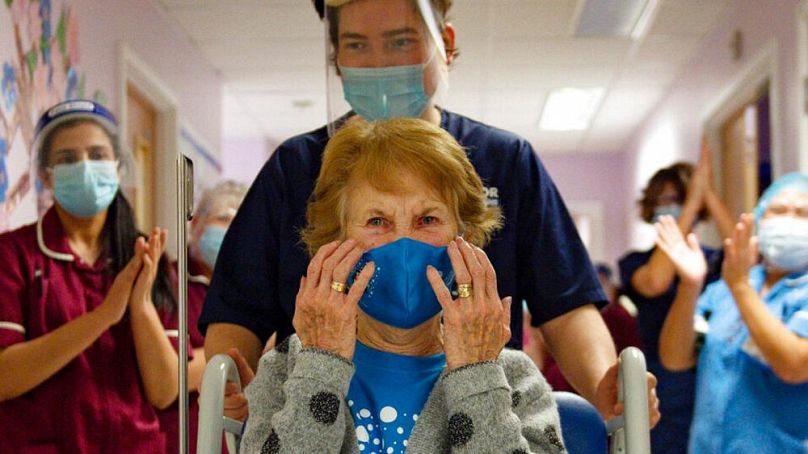COVID-19 submerged Europe's hospitals, tanked the economy, and forced us to avoid other people. One year since it was first reported in Wuhan, here's how the virus changed life in Europe.
It's been a year since the World Health Organization (WHO) first picked up information on a "viral pneumonia" from Chinese authorities in Wuhan.
That pneumonia of unknown origin would in just a few short months cause the worst pandemic the world has seen in a century.
A year on, COVID-19 has killed at least 1.7 million people, infecting over 80.8 million. It devastated European hospitals and forced many countries to heavily restrict people's movements.
Although the virus had been circulating earlier than that fateful December 31 date, the discovery of cases of this virus would set into motion the defining event of 2020, which has impacted all of our lives.
Here's a look at how the COVID-19 pandemic unfolded in Europe.
January 2020: First cases of coronavirus reported in Europe
The WHO first said they were monitoring a cluster of pneumonia cases on January 4, 2020, with a tweet stating that investigations were ongoing after confirming an outbreak with Chinese officials.
Scientifically, some progress occurred in January: the virus' genomic sequence was published by Chinese authorities and a WHO mission to China was sent to learn about the virus response.
The first confirmed death due to the virus was confirmed in China alongside the possibility for human to human transmission. On January 23, people in Wuhan were ordered to stay at home in the first lockdown of the pandemic, which was viewed then as an extreme measure.
The first cases of this novel coronavirus were confirmed in the European region on January 24 with three cases declared in France, all with travel history to Wuhan.
Some European leaders said in January that the chance that the virus would be imported from China was slim, but on January 30, the WHO declared the virus a "public health emergency of international concern".
February 2020: Coronavirus reaches Europe and northern Italy locks down
Things moved rapidly in February as the situation grew more concerning and key missteps around the world hindered the global response.
Rapid contaminations on the Diamond Princess cruise ship, which quarantined for two weeks off the coast of Japan, fuelled international concern about the transmissibility of the disease. A total of 634 of 3,711 passengers tested positive for the virus.
The disease caused by the virus was named COVID-19 by the WHO on February 11, with a warning to countries to be prepared as viruses can wreak more havoc than terrorism.
The first death due to the virus was reported on February 15 in France and by February 21, nine countries had reported cases: Belgium, Finland, France, Germany, Italy, Russia, Spain, Sweden, and the UK.
Amid fear of virus spread, a hotel on the island of Tenerife was also quarantined after a guest tested positive, in one of several examples of drastic actions that left travellers stranded.
But the most significant action in February came as cases began to rise in Italy.
The Italian government issued local lockdowns in the province of Lombardy, where Europe's first serious coronavirus outbreak started.
The European Centre for Disease Control (ECDC) then increased its assessment about the risk of COVID-19 clusters in Europe from moderate to high.
March 2020: European countries lock down amid rising hospitalisations
Many will remember March as the month where life changed in Europe as many countries issued strict lockdowns amid rising hospitalisations and deaths due to the virus.
One of the most stunning moments may have been when Italy issued a regional lockdown on March 8 that extended to the entire country by the next day with all schools and non-essential shops closed. Residents needed a form to leave their homes, justifying any travel in one of the strictest lockdowns issued since the measures in Wuhan.
Many European countries began closing internal borders to Italy amid fears of the spread of the virus and some banned exports of personal protective equipment amid shortages, actions that were condemned and negotiated by EU officials as a lack of solidarity among member states.
COVID-19 was then declared a pandemic by WHO on March 11, with the organisation stating that Europe had become the epicentre. US President Donald Trump issued a travel ban on people coming from the Schengen area, in a move condemned by EU officials.
Belgium closed schools and issued strict restrictions. Spain declared a state of emergency, asking people to stay home. Many countries followed suit with France shutting restaurants, schools and locking down on March 17.
The situation in Italy became an early indicator of how dangerous the virus could be as doctors said they had to pick and choose who to treat due to rapidly overflowing hospitals. An Italian doctor who told Euronews he was forced to work without gloves due to a lack of material died in Codogno.
German Chancellor Angela Merkel called COVID-19 the biggest challenge for the country since reunification. She called on citizens to stay at home in mid-March.
UK Prime Minister Boris Johnson announced a lockdown on March 22, a move that many said was too late to stop rapidly rising infections in the country. The UK now has the highest death toll in Europe.
Plus, days later, Boris Johnson and his health minister both tested positive for the virus.
With many EU countries locked down, concerns increased over some emergency laws. Hungary's Viktor Orban, for one, was heavily criticised for an emergency law that provided him with sweeping powers amid the health crisis.
April 2020: Half of humanity under lockdown
Death tolls rose significantly in April with some Western European countries quickly passing the 10,000 mark and reporting hundreds of deaths per day, but strict restrictions also began to have an impact.
The World Health Organization confirmed that people can be asymptomatic or pre-symptomatic and spread COVID-19, contributing to concerns about the virus' transmissibility.
More than half of the world's population was under some form of COVID-19 restrictions at the beginning of the month. By mid-April, global cases of COVID-19 had topped two million and the International Monetary Fund warned the global economy would suffer its worst year since the 1930s.
In early April, UK PM Johnson spent time in intensive care after testing positive for COVID-19. Criticism also mounted over a lack of preparedness, stating that early testing in the UK and other countries could have helped to avoid the tens of thousands of deaths recorded in Europe.
US President Donald Trump blamed China and the WHO, threatening to halt payment to the international organisation over their handling of the crisis.
Although EU finance ministers agreed on a €500 million emergency funding package to respond to the crisis, many criticised the EU's slow action with the bloc's science chief quitting, reportedly over the pandemic response.
By April 19, there were more than 100,000 deaths recorded in Europe and more than one million infections of COVID-19. But signs showed improvement in hard-hit western European countries.
Germany, which fared better with fewer deaths than its European neighbours, reopened small shops and began testing for antibodies to get a sense of who had already been infected by the virus. Other European countries began planning how they would exit lockdowns, with countries reopening in phases.
Some companies including Pfizer and AstraZeneca received the go-ahead to begin vaccine trials. Daily death tolls in heavily impacted countries also began to decrease.
But fears over unknown quantities relating to the virus remained. For instance, global health bodies alerted that a concerning coronavirus-related condition in children caused inflammation and in some extreme cases, heart problems.
May 2020: Epicentre of epidemic moves to South America
Early May brought with it the easing of COVID-19 restrictions in some European countries with many reporting lower numbers of infections.
There were differences in many countries' restrictions. Masks became mandatory on public transportation in France, for instance, when it was not in the UK.
The WHO warned in mid-May that COVID-19 may never go away, adding that it could be a while before life could return to normal.
In an alarming announcement on May 17, the Danish government said a human may have contracted coronavirus from a mink.
By the end of May, South America was seen as the new epicentre of coronavirus cases while European countries further eased lockdown restrictions. Groups of six people, for instance, were allowed to meet up in England.
England also launched its "test and trace" programme to ramp up testing and contact tracing in an effort to better contain coronavirus spread but many were concerned that the country lifted restrictions too soon.
June 2020: Countries ease up on social distancing
Restaurants reopened in France and schools briefly reopened in England as European countries further eased up on distancing restrictions. France's scientific council declared that the virus was "under control".
In some countries, June also marked a reckoning over the handling of the crisis.
Swedish authorities, who opted for few restrictions on the population, admitted there was "potential for improvement" in their strategy. Sweden reported scores more deaths than neighbours Denmark, Norway and Finland who locked down in the spring.
Cycling also received a boost as people avoided taking public transportation after the first wave of coronavirus hit Europe.
But it wasn't until early June that the WHO recommended wearing a face mask in public amid concerns about asymptomatic transmission of coronavirus.
On June 11, the European Commission said internal borders could open from mid-June and external borders could reopen from July 1.
Meanwhile the OECD warned that the effects of lockdowns would be "unprecedented and long lasting" on economies, particularly in the eurozone.
EU countries also began investing in vaccines, with several member states striking a deal in June for up to 400 million doses of pharmaceutical company AstraZeneca and Oxford's vaccine candidate.
In mid-June, more good news: the cheap steroid dexamethasone was found to reduce COVID-19 death rates for people hospitalised with the virus.
Remdesivir also became the first drug authorised in the European Union to treat COVID-19 after trials showed patients treated with it recovered more quickly.
However, European leaders in June failed to agree on a €750 billion recovery package that would include debt sharing as a tool to help countries harder hit by the pandemic.
WHO's regional office in Europe also warned that in some areas of the region including eastern Europe and central Asia, COVID-19 cases were rising rapidly.
July 2020: A slight return to normal as EU leaders agree to share debt
Pubs reopened in England as much of Europe returned to normal with holidaymakers allowed to travel as countries aimed to spare losses to the tourism sector.
But in some places in Europe, coronavirus continued to spread. Early on in the month, Spain issued a local lockdown to contain rising cases in Catalonia. Travel restrictions were also subject to last-minute changes for certain countries, with the UK updating when people would need to quarantine upon arriving in the country.
Officials in France and Britain also made masks mandatory in indoor public spaces following the steps of other countries.
By the middle of July, more than 13 million cases were confirmed worldwide. Though rates remained low in EU countries, Sweden, Portugal and Bulgaria had some of the highest infection rates in the bloc over the summer.
EU leaders agreed on a historic €1.82 trillion budget on July 21.
The seven-year budget included a €750 billion package for coronavirus recovery that included grants and loans.
August 2020: Young people and holidaymakers blamed for rising cases
Some European countries instituted local lockdowns over the summer in an effort to contain coronavirus cases but as holidaymakers travelled across the bloc, indicators showed cases were starting to rise.
The WHO stressed that young people are not immune to the virus, as cases rose particularly among young adults who had restarted some form of a normal life.
Doctors warned that a second wave could hit European countries as cases increase.
Russia became the first country to register a coronavirus vaccine despite the vaccine not going through phase three trials.
Many French municipalities extended mask wearing in August and cities Paris and Marseille were declared "at risk" areas. Amid a second wave in Spain, nightclubs closed halfway through August.
As cases rose in Germany, the country banned large gatherings through to the end of the year.
WHO's Dr Hans Kluge warned that coronavirus is a "tornado with a long tail", noting that there was a "generalised uptick" in COVID-19 cases in Europe.
September 2020: Infections rise in Europe
Many Europeans returned to work and school with masks from September amid a complicated COVID-19 situation.
Cases continued to rise in some countries with France passing the 10,000 daily infections mark early on in the month. Italy, meanwhile, continued to fare well despite its earlier status as a COVID-19 epicentre.
Stella Kyriakides, European Commissioner for Health and Food Safety, told Euronews that until a safe and effective vaccine becomes widely available, countries will need to adjust to a new normal – and do everything they can to keep the spread of the virus in check.
The WHO warned that deaths could soar in Europe by October and November as countries began to issue more mask mandates and limit gatherings.
Some countries such as the Czech Republic, which had a low infection rate in the spring and had nearly universal mask wearing, saw virus cases spike.
The EU's agency for infectious diseases called on authorities to quickly implement targeted measures to deal with a "worrying increase" in COVID-19 cases stating that the measures implemented were not working.
October 2020: Curfews and stark warnings
Bars and restaurants shut in some metropolitan areas of France in October while Madrid entered a state of emergency as cases rose in Europe and countries scrambled to avoid a second lockdown.
Ireland banned indoor dining and tightened restrictions amid rising cases.
Germany's Robert Koch Institute warned the country could begin seeing 10,000 daily cases if social distancing restrictions weren't issued.
Britain's Boris Johnson introduced a multi-tier system to organise lockdown restrictions with local infection rates determining the level of measures.
More restrictions, including curfews and partial lockdowns, were imposed in several European countries as cases rose in October as the WHO warned that any loosening of restrictions would increase deaths in Europe.
And the news only got worse: European Central Bank chief Christine Lagarde warned that the bloc's economic recovery was uncertain amid rising infections and a second wave.
Germany issued a "lockdown light" at the end of the month and France entered its second national lockdown as intensive care units began to fill up again. Belgium and the UK were quick to follow with second lockdowns.
November 2020: Europe returns to lockdown
The month of November resulted in restrictions once again in many European countries, with warnings from officials that they could last through December as well.
Rising hospitalisations and death tolls served as a stark warning for European countries that experts say had lifted restrictions too quickly over the summer.
Many pointed to failures in testing and tracing contacts as well as reinforcing isolation for contact cases. Even Sweden, which barely had virus measures in the spring, began issuing restrictions.
But November also brought with it signs of progress when US pharmaceutical company Pfizer and Germany's BioNTech announced their candidate COVID-19 vaccine was over 90% effective. US biotechnology company Moderna quickly followed, stating theirs was 94.5% effective.
The first trial results from AstraZeneca and Oxford also provided some hope, showing that the vaccine was up to 90% effective depending on the dosing regime.
But amid partial lockdowns throughout the continent, European countries began rolling out mass testing programmes in order to find asymptomatic carriers and prevent clusters from spreading.
The end of the month was marked by some countries easing restrictions while Hungary and Poland blocked COVID-19 relief at the European level.
December 2020: First vaccines are finally approved
In early December, the UK approved the Pfizer/BioNTech vaccine and began a mass vaccination programme, becoming the first country to approve a COVID-19 vaccine after phase three trial results.
But WHO warned that the approval of a vaccine does not mean the pandemic is over.
European leaders eventually passed a €1.8 trillion budget and coronavirus recovery package as Hungary and Poland, two countries that previously vetoed the budget over a rule of law provision, came onboard.
While some countries eased restrictions, mounting cases in Germany prompted Chancellor Angela Merkel to close non-essential businesses and schools until January 10.
In an alarming development, the United Kingdom then announced that a new coronavirus variant that was more contagious was rapidly spreading in southeast England. Officials backtracked on allowing families to gather for Christmas citing rising cases and hospitalisations.
But a year since COVID-19 was first declared in Wuhan, China, even though the world has suffered immeasurably, for many hope is still on the horizon.
The European Commission approved Pfizer's vaccine on December 21 and member states began rolling out vaccinations on December 27th. As healthcare workers and those who are vulnerable receive vaccines, the pain of 2020 could be turned around in 2021.












